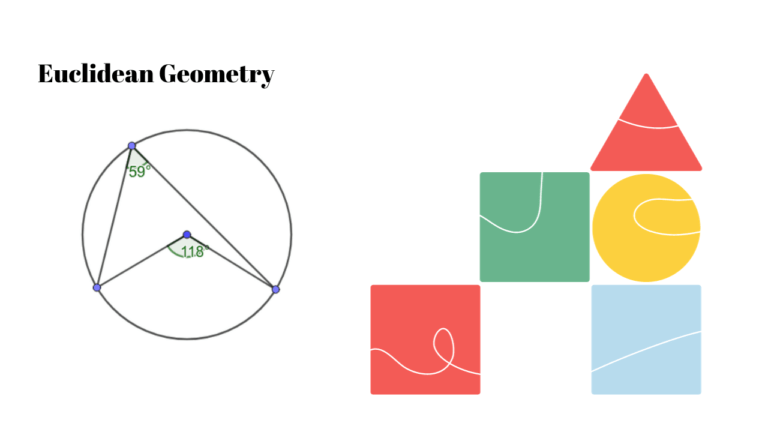Euclidean Geometry: Unlocking the Beauty of Geometric Principles
In the world of mathematics, few branches stand as prominently as Euclidean Geometry. This ancient and elegant discipline has been a cornerstone of mathematical education for centuries. In this comprehensive article, we will delve deep into the realm of Euclidean Geometry, exploring its history, key concepts, practical applications, and its enduring relevance in the modern era. So, let’s embark on a geometric journey that will not only enrich your understanding but also provide valuable insights for students preparing for exams like JEE and IOQM.

The Origins of Euclidean Geometry
Euclidean Geometry owes its name to Euclid of Alexandria, a Greek mathematician who lived around 300 BCE. He compiled the foundational work on this subject in a book known as “Elements.” Euclid’s meticulous approach to geometry laid the groundwork for the systematic study of shapes, sizes, and their properties. His axiomatic method, consisting of self-evident truths or postulates, became a paradigm for logical reasoning in mathematics.
Euclidean Geometry is a branch of geometry that is named after the ancient Greek mathematician Euclid, who is often referred to as the “Father of Geometry.” It is a fundamental and classical area of mathematics that primarily deals with the study of plane geometry in two-dimensional space. Here are the key aspects and details of Euclidean Geometry:
Basic Elements:
- Euclidean Geometry is based on a set of basic elements, including points, lines, and planes.
- A point is a location in space and is represented as a dot.
- A line is a straight path that extends infinitely in both directions. It is represented by a straight line with arrows on both ends.
- A plane is a flat, two-dimensional surface that extends infinitely in all directions.
Axioms and Postulates:
- Euclidean Geometry relies on a set of axioms and postulates, which are assumed to be true without proof. These include statements like “two points determine a unique line” and “a line can be extended infinitely.”
Geometric Figures:
- In Euclidean Geometry, various geometric figures are studied, including triangles, circles, quadrilaterals, and polygons.
- Triangles are three-sided polygons, and the study of their properties is central to Euclidean Geometry.
- Circles are sets of points equidistant from a central point, and they have their unique properties and theorems.
Congruence and Similarity:
- Congruence refers to when two geometric figures have the same shape and size.
- Similarity refers to when two geometric figures have the same shape but may differ in size.
Theorems and Proofs:
- Euclidean Geometry is known for its rigorous proofs. Theorems are statements that are proven true based on axioms and previous theorems.
- Some famous theorems in Euclidean Geometry include the Pythagorean Theorem, which relates to right triangles, and the Parallel Postulate, which deals with parallel lines.
Angles and Measurement:
- Euclidean Geometry also involves the study of angles, their measurement in degrees, and relationships between angles.
- Angles can be classified as acute, obtuse, right, or straight based on their degree measures.
Coordinate Geometry:
- While Euclidean Geometry traditionally deals with geometric shapes and properties, it can also be integrated with coordinate geometry, where points are represented by coordinates on a plane (x, y).
Applications:
- Euclidean Geometry has numerous practical applications in various fields, including architecture, engineering, physics, and computer graphics.
In summary, Euclidean Geometry is a foundational branch of mathematics that explores the properties and relationships of geometric figures in two-dimensional space. It relies on a set of axioms and postulates and is known for its logical proofs and theorems that have far-reaching applications in the real world.
Euclid’s Definitions, Axioms and Postulates
Euclid’s “Elements” is one of the most influential mathematical works in history, and it starts with a set of definitions, axioms, and postulates that form the foundation of Euclidean Geometry. Let’s delve into each of these:
1. Definitions:
- Euclid’s “Elements” begins with a series of definitions to establish a common language for discussing geometric concepts. These definitions are precise and unambiguous.
- For example, Euclid defines a point as “that which has no part” and a line as “breadthless length.”
2. Axioms (also known as Common Notions):
Axioms are self-evident truths or statements that are accepted without proof. They serve as the foundational principles upon which all other geometric reasoning is built.
Euclid’s Axioms, or Common Notions, include statements like:
- “Things that are equal to the same thing are also equal to one another.”
- “If equals are added to equals, the wholes are equal.”
- “If equals are subtracted from equals, the remainders are equal.”
These axioms provide the basis for logical reasoning in geometry. They are essential for constructing proofs and demonstrating the validity of geometric theorems.
3. Postulates (also known as Postulata or Postulatory Axioms):
Postulates are specific statements that describe geometric properties and relationships, and they are also accepted without proof. They are the building blocks for constructing geometric figures and solving problems.
Euclid’s Postulates include:
- “A straight line can be drawn from any one point to any other point.”
- “A finite straight line can be extended continuously in a straight line.”
- “A circle can be described with any center and radius.”
- “All right angles are equal to one another.”
These postulates are crucial for constructing various geometric figures, such as lines, angles, and circles, and for defining fundamental concepts in geometry.
Euclid’s “Elements” is organized systematically, starting with these definitions, axioms, and postulates. From there, Euclid builds a comprehensive system of geometry, proving numerous theorems and propositions based on these foundational principles. His work has had a profound and lasting impact on the development of mathematics and continues to be studied and admired to this day.
Euclidean Geometry is a branch of mathematics that deals with the study of geometric figures and properties in two-dimensional space, based on the axioms and postulates of the ancient Greek mathematician Euclid.
Euclid was an ancient Greek mathematician known as the “Father of Geometry.” He compiled and organized the fundamental principles of geometry in his work called “Elements,” which served as the foundation for the study of geometry for centuries.
The basic elements include points, lines, and planes. Points are locations in space, lines are straight paths extending infinitely, and planes are flat, two-dimensional surfaces.
Axioms and postulates are foundational statements in geometry that are accepted as true without proof. They provide the basis for logical reasoning and proof in geometric theorems.
Some famous theorems include the Pythagorean Theorem, which relates to right triangles, and the Parallel Postulate, which deals with parallel lines. There are many more theorems related to triangles, circles, and polygons.
Congruent figures have the same shape and size, while similar figures have the same shape but may differ in size. Congruent triangles, for example, have all corresponding sides and angles equal, while similar triangles have proportional sides.
Yes, Euclidean Geometry has practical applications in various fields like architecture, engineering, physics, and computer graphics. It is used to solve problems involving shapes, distances, and angles.
Angles are formed by two rays with a common endpoint (vertex). They are measured in degrees, with a full circle having 360 degrees. Common angle classifications include acute, obtuse, right, and straight angles.
Yes, non-Euclidean geometries, such as spherical and hyperbolic geometry, have been developed, where the Parallel Postulate is modified. These geometries have applications in various areas, including physics and cosmology.
To excel in Euclidean Geometry, practice solving a wide range of geometry problems. Study theorems, practice proofs, and explore advanced topics like coordinate geometry and transformations. Participate in geometry competitions and seek guidance from experienced math teachers or mentors.
There are numerous textbooks, online courses, and math problem-solving websites that offer resources and practice problems specifically designed for Euclidean Geometry. Some reputable sources include Khan Academy, Art of Problem Solving (AoPS), and various mathematics competition websites.






